George Patton
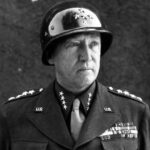
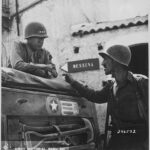 In any job, there can be personality conflicts, and Lieutenant General George S Patton was not liked by every other officer he served with. Nevertheless, like him or not, Lieutenant General George S Patton’s 3rd Army was successful is battle. On March 22, 1945, soldiers of the United States’ Third Army, under the command of Lieutenant General George S Patton, crossed the Rhine River at Oppenheim, south of Mainz. Patton’s arrival was weeks ahead of his rival, British Field Marshal Bernard Law Montgomery. When Patton went to battle, he was known to fight his own higher command structure nearly as hard as he did the Germans. His comments were often harsh and probably ruffled some feathers, but he was known to get the job done. He was also known for moving farther and more aggressively than ordered, and even having his troops pose as First Army soldiers in order to steal fuel from that unit’s stores in order to maintain their own advance to the east. By March 29, Patton had captured Frankfurt. Then Patton, commonly called “Old Blood and Guts” continued his march east.
In any job, there can be personality conflicts, and Lieutenant General George S Patton was not liked by every other officer he served with. Nevertheless, like him or not, Lieutenant General George S Patton’s 3rd Army was successful is battle. On March 22, 1945, soldiers of the United States’ Third Army, under the command of Lieutenant General George S Patton, crossed the Rhine River at Oppenheim, south of Mainz. Patton’s arrival was weeks ahead of his rival, British Field Marshal Bernard Law Montgomery. When Patton went to battle, he was known to fight his own higher command structure nearly as hard as he did the Germans. His comments were often harsh and probably ruffled some feathers, but he was known to get the job done. He was also known for moving farther and more aggressively than ordered, and even having his troops pose as First Army soldiers in order to steal fuel from that unit’s stores in order to maintain their own advance to the east. By March 29, Patton had captured Frankfurt. Then Patton, commonly called “Old Blood and Guts” continued his march east.
Frankfurt am Main, which means “On the Main” River, in western Germany, was the mid-19th century capital of Germany, until it was annexed by Prussia in 1866, in a move that ended its status as a free city, and thereby ending its reign as capital. When Germany was integrated into a united German nation, Frankfurt developed into a significant industrial city, making it a prime target for Allied bombing during the war. Bombing began in July of 1941, during a series of British air raids against the Nazis. By March of 1944, Frankfurt suffered major damage during a raid in which 27,000 tons of bombs were dropped on the nation in a single month. As a result, Frankfurt’s medieval Old Town was virtually destroyed.
Like him or not, Patton was a capable warrior. During the Battle of the Bulge, in December of 1944, General Patton broke through the German lines of the besieged Belgian city of Bastogne. The brave defenders of that city were so thankful for the assistance. Patton continued to push the Germans to the east, heading for his goal…to cross the Rhine. He was so determined that he didn’t care if he had to take down every single bridge along the route, in order to achieve his objective. Upon his arrival, Patton found one bridge…the Ludendorff Bridge, located in the little town of Remagen had not been destroyed. The American troops had already made a crossing on March 7, 1945, in a single great moment in the war and in history. Historically, no enemy army had crossed the Rhine since Napoleon accomplished the feat in 1805. Now there were two. The March 7th crossing and Patton’s grand crossing on March 22nd, and from the bridgehead created there, “Old Blood and Guts” and h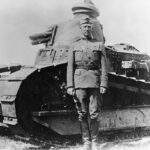
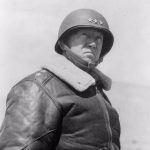 is 3rd Army headed east and captured Frankfurt on March 29, 1945.
is 3rd Army headed east and captured Frankfurt on March 29, 1945.
Still, Patton didn’t stop there. He crossed through southern Germany and into Czechoslovakia, at which point, he was given an order not to take Prague, the capital. It was to be saved for the Soviets to take. After all that, you might expect Patton to be furious, but uncharacteristically, he was not. Nevertheless, Patton desperately wanted to liberate Prague, probably for political, as well as personal reasons. Patton was a great warrior, but he was not above wanting the headlines.
 In the final years of World War II, both the Allied and Axis Powers knew that there was no chance of defeating Hitler without cracking his grasp on Western Europe, and both sides knew that Northern France was the obvious target for an amphibious assault. Hitler’s army seemed to be everywhere. That said, the Allied forces knew they had to come up with a way to “fool” the leader of the Third Reich. Hitler arrogantly thought that he knew what the Allied forces were planning, and that was the best way to create his downfall. The German high command assumed the Allies would cross from England to France at the narrowest part of the channel and land at Pas-de-Calais. The Allies used that to their advantage and decided on the beaches of Normandy…some 200 miles to the west. The beaches of Normandy could be taken as they were, but if the Germans added to their defense by moving their reserve infantry and panzers to Normandy from their garrison in the Pas-de-Calais region, the invasion would be a disaster.
In the final years of World War II, both the Allied and Axis Powers knew that there was no chance of defeating Hitler without cracking his grasp on Western Europe, and both sides knew that Northern France was the obvious target for an amphibious assault. Hitler’s army seemed to be everywhere. That said, the Allied forces knew they had to come up with a way to “fool” the leader of the Third Reich. Hitler arrogantly thought that he knew what the Allied forces were planning, and that was the best way to create his downfall. The German high command assumed the Allies would cross from England to France at the narrowest part of the channel and land at Pas-de-Calais. The Allies used that to their advantage and decided on the beaches of Normandy…some 200 miles to the west. The beaches of Normandy could be taken as they were, but if the Germans added to their defense by moving their reserve infantry and panzers to Normandy from their garrison in the Pas-de-Calais region, the invasion would be a disaster.
In what would become an ingenious plan, the Allied intelligence services created two fake armies to keep the Germans on their toes. One would wonder how they proposed to pull that off. The Allies created two “Ghost Armies.” One would be based in Scotland to create a supposed invasion of Norway and the other headquartered 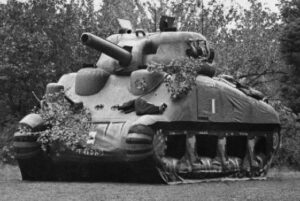 in southeast England to threaten the Pas-de-Calais. While the operation in Scotland relied mainly on fake radio traffic and the feeding of false information to double agents to create the impression of a substantial army, the southern “Ghost Army” had to seem much more real. The fortitude South was well within the range of prying German ears and eyes, so fake chatter alone would be uncovered too quickly. It had to look and sound like a substantial army was building up in southeast England. They needed boots on the ground there, without actually using too much of their precious manpower. That seems like a monumental task.
in southeast England to threaten the Pas-de-Calais. While the operation in Scotland relied mainly on fake radio traffic and the feeding of false information to double agents to create the impression of a substantial army, the southern “Ghost Army” had to seem much more real. The fortitude South was well within the range of prying German ears and eyes, so fake chatter alone would be uncovered too quickly. It had to look and sound like a substantial army was building up in southeast England. They needed boots on the ground there, without actually using too much of their precious manpower. That seems like a monumental task.
Enter George and his imaginary men. Patton was put in charge of leading a fake army, commonly known as the “Ghost Army” as part of a massive counterintelligence operation preceding D-Day. The “Ghost Army” was an army of inflatable tanks, rubber airplanes, and fake radio signals designed to trick the German army. The mission was insanely successful. The “Ghost Army” was a United States Army tactical deception unit used during World War II officially known as the 23rd Headquarters Special Troops. The 1100-man unit was given a 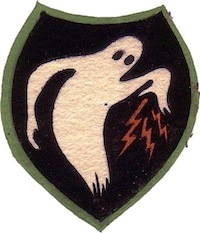 unique mission within the Allied Army. Their orders…impersonate other Allied Army units to deceive the enemy. It was simple, but it wouldn’t be easy.
unique mission within the Allied Army. Their orders…impersonate other Allied Army units to deceive the enemy. It was simple, but it wouldn’t be easy.
By the evening of June 6, 1944, in what would become known as D-Day, the First Army landed at Normandy. The battle was on, and without the extra troops Hitler might have sent if he wasn’t misled so completely. By June 23, 1945, the 23rd Headquarters Special Troops was on its way home after having served with four US armies through England, France, Luxembourg, Belgium, Holland, and Germany. During their tenure, they put on what many would call a “traveling road show” utilizing inflatable tanks, sound trucks, fake radio transmissions, scripts, and pretense. They staged more than 20 battlefield deceptions, often operating very close to the front lines. While their missions and their work were amazing, their story was kept secret for more than 40 years after the war, until it was declassified in 1996.
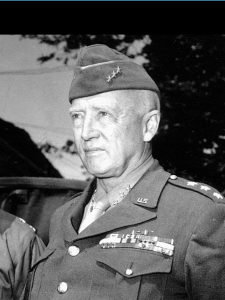 In many of the wars there have been in our world, one thing seems to be a constant…the atrocities against prisoners of war, and even the citizens of the evil nations we are fighting against. World War II probably saw some of the worst atrocities, during the Holocaust. It was during that time that prison camps like Auschwitz-Birkenau, Buchenwald, Chelmno, Dachau, and Terezin, just to name a few, were used either for the murder of Jews and anyone else Hitler felt was not of the standard of people he thought they should be, or the prisoners they held were used as forced labor.
In many of the wars there have been in our world, one thing seems to be a constant…the atrocities against prisoners of war, and even the citizens of the evil nations we are fighting against. World War II probably saw some of the worst atrocities, during the Holocaust. It was during that time that prison camps like Auschwitz-Birkenau, Buchenwald, Chelmno, Dachau, and Terezin, just to name a few, were used either for the murder of Jews and anyone else Hitler felt was not of the standard of people he thought they should be, or the prisoners they held were used as forced labor.
Buchenwald was not an Annihilation camp, but that doesn’t mean that it was a easy existence. The Germans were not good to their prisoners. Prisoners from all over Europe and the Soviet Union…Jews, Poles and other Slavs, the mentally ill and physically-disabled from birth defects, religious and political prisoners, Roma and Sinti, Freemasons, Jehovah’s Witnesses (then called Bible Students), criminals, homosexuals, and prisoners of war, worked primarily as forced labor in local armaments factories. It seems as if there were no groups who were exempt. If they didn’t fit into Hitler’s mold, they were contained in the camps, or killed. Buchenwald concentration camp (German: Konzentrationslager, which in English, literally means beech forest) was a German Nazi concentration camp established on the Ettersberg (Etter Mountain) near Weimar, Germany, in July 1937. It was one of the first and the largest of the concentration camps on German soil, following Dachau’s opening just over four years earlier.
On April 11, 1945, four soldiers in the Sixth Armored Division of the US Third Army, commanded by General 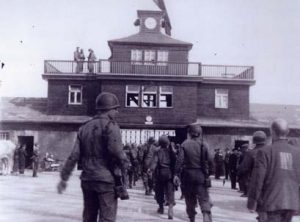 George S Patton, liberated the Buchenwald concentration camp. Just before the Americans arrived, the camp had already been taken over by the Communist prisoners who had killed some of the guards and forced the rest to flee into the nearby woods. They knew the end was near for them anyway, and there seemed no further reason to stand and fight. I suppose that the fact that the guards had deserted their posts, made it possible for just four soldiers to take over and liberate the camp. On the morning of April 12, 1945, soldiers of the 80th Infantry Division arrived in the nearby town of Weimar and found it deserted except for some of the liberated prisoners roaming around. The townspeople were cowering in fear inside their homes…bomb-damaged from the February 9, 1945 air raid that was to precede the liberation process. I would think that if any of them were a part of the concentration camp, there would be reason to fear the prisoners in town, because they had a reason to kill them, after all they had been through in German custody.
George S Patton, liberated the Buchenwald concentration camp. Just before the Americans arrived, the camp had already been taken over by the Communist prisoners who had killed some of the guards and forced the rest to flee into the nearby woods. They knew the end was near for them anyway, and there seemed no further reason to stand and fight. I suppose that the fact that the guards had deserted their posts, made it possible for just four soldiers to take over and liberate the camp. On the morning of April 12, 1945, soldiers of the 80th Infantry Division arrived in the nearby town of Weimar and found it deserted except for some of the liberated prisoners roaming around. The townspeople were cowering in fear inside their homes…bomb-damaged from the February 9, 1945 air raid that was to precede the liberation process. I would think that if any of them were a part of the concentration camp, there would be reason to fear the prisoners in town, because they had a reason to kill them, after all they had been through in German custody.
Recently, I found out that General George S Patton was my 8th cousin twice removed, on my grandmother, Hattie Pattan Byer’s side. I had always suspected a relationship there, with my grandmother’s maiden name being Pattan, but I didn’t expect it in the way it came about, since it is from my grandmother Elizabeth Shuck, who married my grandfather David Pattan, and not from the Pattan side outright. I have always liked General 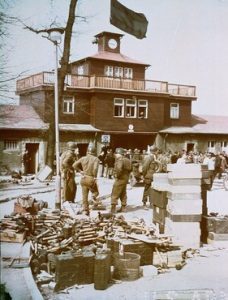 Patton, and I think it is really awesome that he is related to my family. In my opinion, he was an amazing general. He served as a commissioned officer in the United States Army for 36 years. He served in three major conflicts (Mexican Punitive Expedition, World War I and World War II) during his military career. He was awarded with the Distinguished Service Cross with one oak leaf cluster, the Army Distinguished Service Medal with two oak leaf clusters, the Navy Distinguished Service Medal, the Silver Star with one oak leaf cluster, the Legion of Merit, the Bronze Star Medal, the Purple Heart, the Silver Lifesaving Medal, the Mexican Border Service Medal, the World War I Victory Medal with four bronze campaign stars, the American Defense Service Medal, the European-African-Middle Eastern Campaign Medal with one silver and two bronze campaign star, the World War II Victory Medal, and posthumously…the Army of Occupation Medal with Germany clasp. That’s quite a war record. I’m sure the prisoners that he liberated felt that he very much earned them for his war skills.
Patton, and I think it is really awesome that he is related to my family. In my opinion, he was an amazing general. He served as a commissioned officer in the United States Army for 36 years. He served in three major conflicts (Mexican Punitive Expedition, World War I and World War II) during his military career. He was awarded with the Distinguished Service Cross with one oak leaf cluster, the Army Distinguished Service Medal with two oak leaf clusters, the Navy Distinguished Service Medal, the Silver Star with one oak leaf cluster, the Legion of Merit, the Bronze Star Medal, the Purple Heart, the Silver Lifesaving Medal, the Mexican Border Service Medal, the World War I Victory Medal with four bronze campaign stars, the American Defense Service Medal, the European-African-Middle Eastern Campaign Medal with one silver and two bronze campaign star, the World War II Victory Medal, and posthumously…the Army of Occupation Medal with Germany clasp. That’s quite a war record. I’m sure the prisoners that he liberated felt that he very much earned them for his war skills.

